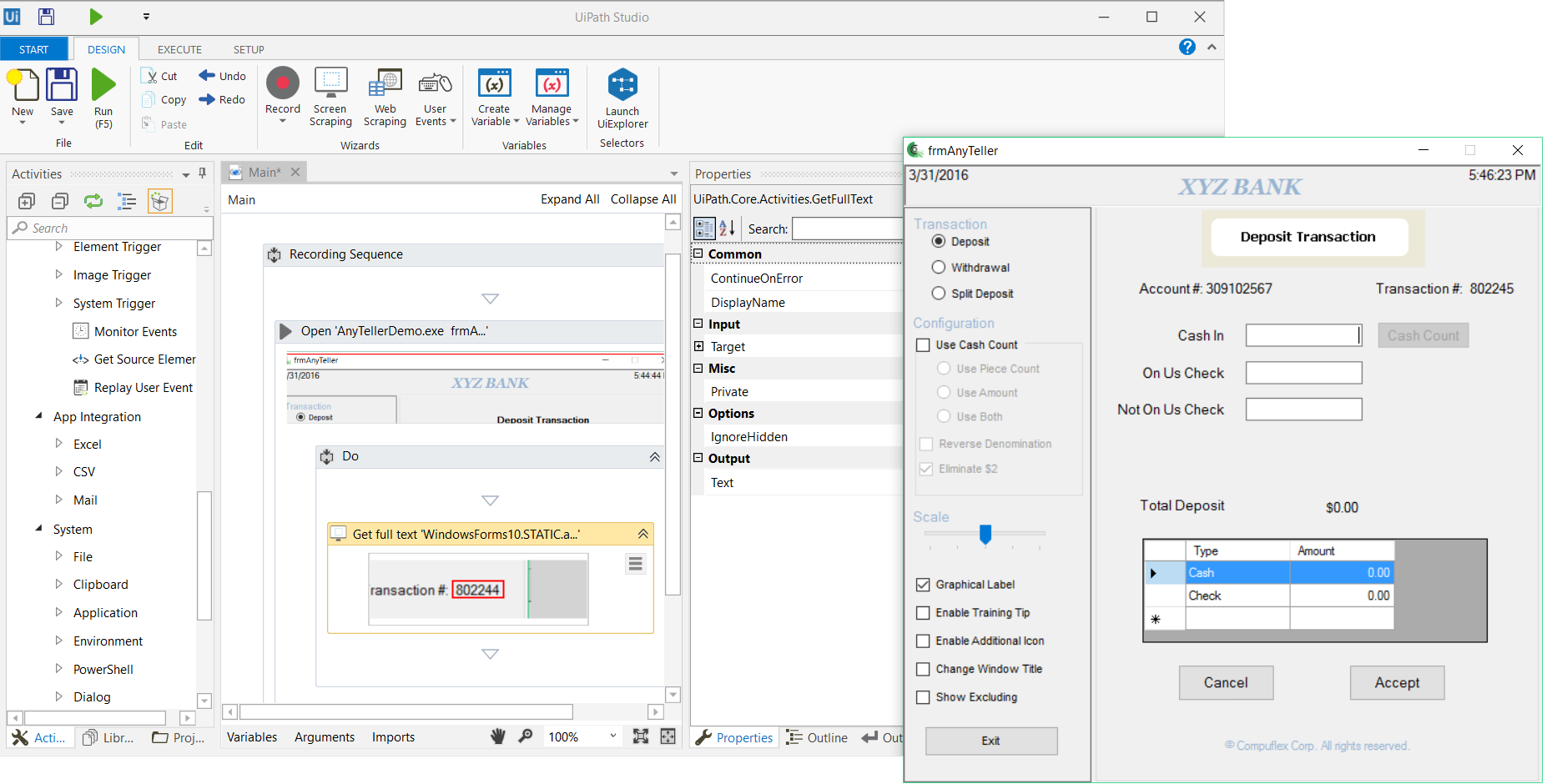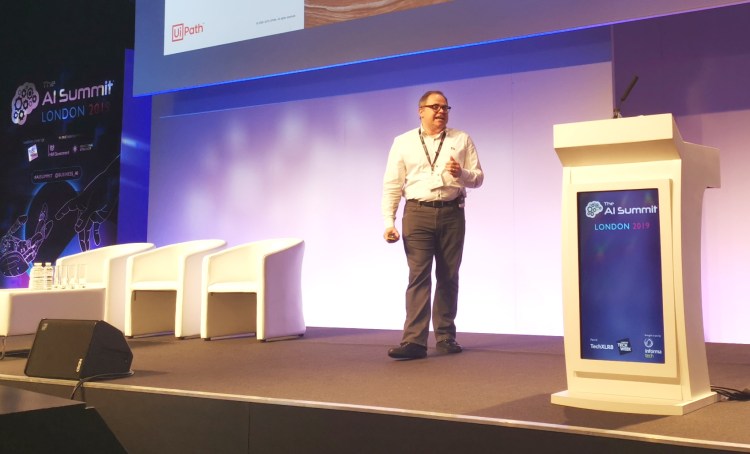Watch all the Transform 2020 sessions on-demand here.
“In three to five years, RPA and AI will become a commodity productivity tool, the same way as you use Excel and PowerPoint,” proclaimed Boris Krumrey, chief robotics officer at UiPath, at the AI Summit in London last week.
Robotic process automation, or RPA as it’s often called, isn’t the sexiest concept to emerge from the technology sphere, but it is a fast-growing industry — and it’s one that could reshape the workplace of the future.
RPA brings automation to laborious enterprise tasks through smart “software robots” that replicate repetitive (and tedious) tasks through rules-based processes. The technology is installed on top of popular business applications, which may include enterprise resource planning (ERP) software or customer relationship management (CRM) tools, and it monitors what humans do so that it can emulate them. If you ever have to carry out manual data entry tasks for hours or days at a time, RPA could be the answer to your prayers.
The state of play
Some estimates peg the RPA industry at $2.3 billion today, and it could grow to more than $4 billion by 2022. In the past year alone, some major cash injections have been put into RPA companies, including Automation Anywhere, which secured $300 million from SoftBank; Kryon, which raised $40 million; Softomotive, which nabbed $25 million; and Automation Hero, which reeled in $14.4 million.
June 5th: The AI Audit in NYC
Join us next week in NYC to engage with top executive leaders, delving into strategies for auditing AI models to ensure fairness, optimal performance, and ethical compliance across diverse organizations. Secure your attendance for this exclusive invite-only event.
And then a couple of months back, UiPath raised a gargantuan $568 million round of funding at a $7 billion valuation.
UiPath was founded out of Bucharest, Romania in 2005, though it was originally known as Deskover. In the beginning, it was more of a software outsourcing company that built automation libraries and SDKs for major companies such as Google and Microsoft. Armed with a new name in 2015, UiPath doubled down on RPA and moved its headquarters to New York City two years later.
With UiPath Studio, companies can access prebuilt activities and design automation processes visually through constructing diagrams, while the UiPath Orchestrator is where companies can deploy and manage all their robots and processes.

Above: UiPath Studio for designing processes
Although RPA is a fast-growing industry, these kind of productivity tools are still relatively low key — they’re not “mainstream” in the same way as Microsoft Office or Google Docs. But that is something that UiPath predicts will change in the coming years, with Krumrey outlining key steps the industry will have to go through to get to a point where automation tools such as RPA are part of the mainstream.
Mindset
For RPA and automation tools to become truly commoditized, they first have to be available for everyone to use — a “robot for every employee,” as Krumrey puts it. And it’s at this point where people will start to think “how can I automate this task” before they actually start doing it. It’s about a change of mindset, where automation becomes a default consideration when doing just about anything.
Krumrey highlighted an interesting example of this, where one of its customers is meshing a UiPath robot with computer vision to watch physical mailboxes — whenever a package or letter lands in a box, the person aligned with that box receives an email.

Above: UiPath robot using deep learning computer vision to watch physical mailboxes
But in theory, this could work in other scenarios, including mission-critical control rooms. “You could apply that to anything — controlling a power plant, whatever you want,” Krumrey said. “It’s a really, really powerful capability that you can enable with our bots.”
From UiPath’s perspective, it is engaging in various education initiatives to spread the word, and it has previously committed to training 1 million students by 2020 through universities around the world, which includes learning how to automate workplace tasks such as invoice processing or handling customer conversations. The company also offers free RPA training online.
RPA + AI
But one of the key sticking points for RPA to properly gain momentum is its current limitations — it works well with structured data, the kind that is found in business applications such as spreadsheets. But it’s not yet in tune with the human psyche; it can’t predict intent or preempt actions. It’s not cognitive.
Applying AI to RPA will be a major next step for the industry, but there are obstacles — RPA and AI-focused data science teams usually operate in separate silos, in terms of the tools they use, the skills they have, and the processes they follow. A few months back, UiPath debuted a new early access program for a product it’s calling AI Fabric, which is designed to “break down the barriers between RPA and data science teams” to let users apply the “cognitive power of AI” to any software currently automated by RPA.
Ease-of-use is key here. Users will be able to “drag and drop” AI skills, developed by UiPath and some 60 of its partners (including Google), into their automation workflow — this will help make existing UiPath robots more cognitive. The AI skill parameters can be customized, while suitably resourced companies will be able to integrate their own AI models.
“There’s already a lot of machine learning models that are solving a problem that you can just drag, drop, and apply,” Krumrey said. “One thing is to emulate humans, which is classical RPA. But the other part is that we have RPA and AI very closely integrated.”
There are, of course, other factors at play in terms of the timeframe for “commoditizing” RPA and AI tools. Krumrey referred to the need for orchestration — “we need to be able to run multiple automation rules” — and defining an automation operating model.
Whether AI-infused RPA tools will be commodities inside five years remains to be seen, but there is another elephant in the room here — and that is cost. While UiPath is free to use when learning RPA, to deploy it can cost thousands of dollars per year, depending on which parts of the platform are used and how many licenses are required. It’s true that other productivity tools come with licensing fees, but encouraging buy-in to this kind of technology at scale, across companies of all sizes, could be tough.
Some RPA companies, such as Workfusion, offer a basic “starter” package with limited features and functionality. And perhaps more of this is needed across the board — a “freemium” model to encourage uptake across the board.
But with automation creeping into all manner of industries through various conduits, the business case for investing in RPA and AI will only grow. And UiPath is gearing up to meet this demand. “We believe that RPA driving the bottom-up automation, combined with drag-and-drop AI skills, will be the next generation of office productivity tools,” the company said.


